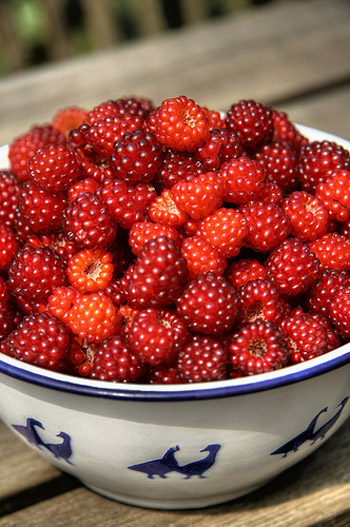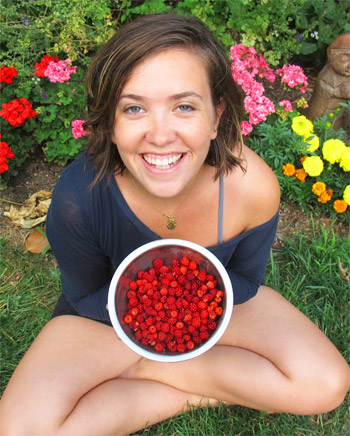|
|
|
 , ,
Font size |
Encyclopedia of Health Benefits of Berries

30. Wineberries:
These are red or orange in color and become ripe around summer or early
autumn. Contrary to the name, these are not as fit to make wines due to their
tartness.
Wineberries are a kind of raspberry. The scientific name, Rubus phoenicolasius,
means �raspberry with purple hairs.� Native to eastern Asia, it was introduced
into eastern America in the late 1800s for use as breeding stock in developing
new raspberry varieties. It is still used in breeding programs today as well as
in the detection of viruses harmful to other raspberry plants.
But it is also a good example of the adage that one man�s wildflower is another
man�s weed. Wineberry is a vigorous grower that has escaped cultivation and can
spread to form dense thickets, crowding out native plants in natural ecosystems.
It is considered an invasive weed in many states, including Pennsylvania. It
prefers moist soils in sun or light shade and is common in forests, fields,
stream and wetland edges, open woods, and roadsides.
Wineberry grows quickly; it reproduces readily by seed, suckers, and rooting
cane tips. Its upright stems, or canes, can grow to 9 feet in length, arching
over to touch the ground, where the tips root to expand its reach. These canes
are covered in gland-tipped red hairs, along with short spines, that give them a
fuzzy reddish appearance throughout the year � a good identifying character.
The leaves are comprised of 3 roundish leaflets (main stems have leaves that may
have 5 leaflets), with toothed margins, green above with purplish veins, and
distinctly white underneath with a woolly feel � another good identifying
feature.
The small pinkish-white flowers bloom in late spring, clustered at the tips of
side shoots on 2-year-old canes, and are followed in about a month by the
developing fruit, which botanically is not a berry but an �aggregate of
drupelets.� What we call a berry, in all Rubus species, is actually a collection
of small juicy drupes, each of which contains a seed, clustered around the
receptacle, the cone-shaped core. In wineberries and raspberries, the receptacle
is left behind when you pick the ripe fruit; in blackberries, the receptacle
comes off with the fruit.
Wineberries color from green to yellow to orange-red to a bright and shiny
scarlet-red when mature, usually from late June through July. As the fruit
develops, it is protected by the calyx � a remainder of the flower � that is
covered with the same gland-tipped red hairs as found on the canes, each of
which exudes tiny drops of sticky fluid. The calyx folds back as the fruit
reaches maturity. Ripe fruit will be shiny, bright red, and slightly sticky to
the touch, with a yellowish-white receptacle � more good identifying
characteristics.
Wineberries taste much like flavorful raspberries, but juicier and a bit more
sour, and contain similar health benefits � a good source of vitamin C,
antioxidants, minerals, and fiber. The berries are fragile and, once picked,
last only a few days in the refrigerator, but they freeze well. They can be
eaten fresh, or used in desserts, fruit salads, and sauces. They make wonderful
jam and good wine, too. So, if life hands you wineberries, make wineberry pie!
Not many of us have heard about wineberry wine because of its geographical
limitation to New Zealand and Eastern parts of USA. Wineberry wine features a
variety of antioxidant rich properties that make it stand out among other wines
like strawberry and raspberry wines that are closely related to it. It is known
to introduce compounds for better immune support, improve blood flow, reduce bad
cholesterol level and speeds up the weight loss process. A complete guide to the
health benefits conferred by wineberry wine goes below.
Health Wonders of Wineberry Wine
Weight Loss Therapy
Wineberry wine is known to expedite the fat burning process and likewise
help in reducing weight to surprising extent. The major reason behind weight
loss triggering process is the presence of ketone compounds exclusively in
wineberry. Wineberry ketone as it is scientifically called, disrupts the normal
process of fat deposition and encourages the metabolism of fat in fatty tissues.
It also results in natural release of adinopectin compound that counteracts the
effects of leptin molecule present in our tissues. Leptin molecules are
fundamentally responsible for obesity and increase in cholesterol level.
Adinopectin, which is a hormone negates the effects of leptin and thus acts as a
stimulant for weight loss. Due to this unique characteristic of wineberry wine,
it has been recommended for corpulent people who are facing the highest
threshold of life threatening diseases.
Elixir of Life
 Wineberry wine has unique antioxidants that protects against cell damage and
perform tissue repairmen in better way. It is said that wineberry wine in
miniscule dose is enough to prevent any internal tissue damage and also speeds
up the recovery of tissues. This elixir of life as it is rightly said is one of
the good reasons behind longevity. People who drink wineberry wine regularly are
known to live longer and healthier, Japanese and Korean people provide this
proof. With high level of antioxidant rich nutrition, it prevents the occurrence
of cancer and especially skin and breast cancer. Antioxidants in wineberry wine
eliminate the toxic wastes that are result of metabolism. They are protective to
both heart and liver. Wineberry wine has unique antioxidants that protects against cell damage and
perform tissue repairmen in better way. It is said that wineberry wine in
miniscule dose is enough to prevent any internal tissue damage and also speeds
up the recovery of tissues. This elixir of life as it is rightly said is one of
the good reasons behind longevity. People who drink wineberry wine regularly are
known to live longer and healthier, Japanese and Korean people provide this
proof. With high level of antioxidant rich nutrition, it prevents the occurrence
of cancer and especially skin and breast cancer. Antioxidants in wineberry wine
eliminate the toxic wastes that are result of metabolism. They are protective to
both heart and liver.
Anti-inflammatory Agent
The wine is carries the excellent property of anti-inflammation. It has Vitamin
C , Vitamin E and certain immune boosting enzymes that ultimately help in
reducing the inflammatory process and gives a performance boost to immune
system. To mention specifically, there is release of cytokines (special
signaling molecules that are directly involved in killing pathogens that invade
immune system) by triggering action of wineberry compounds. You are more
resistant towards any sort of common bacteria or virus attacking your system.
Other Related Health Benefits
Wine made from wineberry leads to expulsion of toxic waste and at the same time,
it neutralizes the ill effects of any kind of poison existing in our body,
thisis due to quercetin compound present in it. Compond in wineberry is similar
to Vitamin A and thus helps in fighting eye diseases.
Next..
Dated 12 March 2013

|
|
|
|
|
|
|









